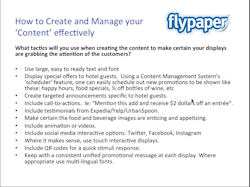While transit agencies are looking to digital signage in order to grow revenues, getting a good return on investment takes more than installing electronics and DVR’s.
Digital signage experts said in order to optimize returns on signage investment and to get the most out of advertising efforts, units need to engage customers and target them for specific products.
“Digital signage becomes an integral part of the enterprise,” said Angelo Kosmidis, director of business development for Capital Networks. “It’s not just about adding canned content. It can really take shape based on what’s happening within the rest of your organization.”
During a webinar Aug. 21 on generating sales lift with digital signage content, strategy architect Lyle Bunn said a recent survey on future trends of digital signage showed 33 percent of those polled are looking to increase their investment in digital signage because of the increase in sales lift units can bring.
But when placing them in areas where people are going to be waiting for something, Bunn said experts recommend messages no more than three seconds in length to attract possible consumers. It’s also recommended signage users have user generated content in order to engage customers.
“Once you’re able to grab the attention of the customer, now you have them interacting with the display,” said Joseph Hacker, national sales manager for Flypaper.
Hacker said large, easy to read fonts are crucial in short messaging, which can provide consumers with a clear message. Videos or animations can also be beneficial, in addition to QR codes in order to get customers to interact with the signs.
The use of targeted messaging is also important, Hacker said, such as when a hotel uses signage to welcome guests. But just as crucial is making sure customers will engage with signage as quick as possible, such as offering a deal to customers who mention the ad at a local restaurant to get a discount.
“Make sure it includes a call to action,” Hacker said. “(I)t offers an immediate return on investment.”
Hacker said social media is also key in engaging customers and touch screen systems should be considered wherever they make sense.
Kosmidis said it’s important for organizations to storyboard what a potential digital signage system will look like, but in many cases it will evolve and change.
Kosmidis encourages signage purchasers to invest in facial recognition as it’s finally mature and means messages can be targeted towards consumers based on age and gender. Near field communications is are also moving into the signage world, which allows for consumers to use their smart phones to interact with a sign and collect a coupon or other deal.
“Not only does that sort of technology help drive sales and combat showrooming, it can also give you and effective measurement tool,” Kosmidis said. “You can have unique url’s per location and measure how many times someone touches a phone to a display.”

Joe Petrie | Associate Editor
I came to Mass Transit in 2013 after spending seven years on the daily newsbeat in southeastern Wisconsin.
Based in Milwaukee, I worked as a daily newspaper reporter with the Waukesha Freeman from 2006-2011, where I covered education, county and state government. I went on to cover courts for Patch.com, where I was the main courts reporter in the Metro Milwaukee cluster of websites.
I’ve won multiple awards during the course of my career and have covered some of the biggest political events in the past decade and have appeared on national programs.
Having covered local government and social issues, I discovered the importance of transit and the impact it can have on communities when implemented, supported and funded.




